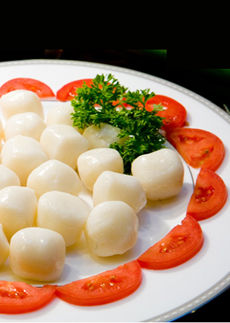TIP OF THE DAY: Raw Scallops, “Scallop Sashimi”
|
|
Both sea scallops and the smaller bay scallops are delicious raw. Bay scallops have an even sweeter, more delicate flavor that is wonderful plain, with no seasoning whatsoever (although some people enjoy a squeeze of lemon or lime). In fact, we think they taste best when raw. In season, you can find them at sushi bars, served gunkan-style (wrapped in a seaweed “boat”) or in a cucumber cup. Bay scallops are what most people picture when they think of scallops. The fluted shells are between two and three inches wide. Sea scallops have much larger, saucer-sized shells that are very flat, without flutes. For a light first course—that just happens to be nutritious and low in calories—serve raw scallops. If your family doesn’t like the idea of “raw,” call it “scallop sashimi” or use the Italian word, “crudo.” You can serve the scallops family-style on a platter, or as individual servings atop a lettuce leaf, watercress, shredded cucumber, tomato concasse or other salad vegetable. Think beyond the plate: The scallops will look terrific in a Martini glass or glass dessert dish. |
|
|
How To Buy Scallops It’s always best to buy seafood the day you plan to use it. When you buy fresh scallops, they should have a clean scent and no “fishy” aroma. The scallops also should be beige, not white. White scallops indicate treatment with sodium tripolyphosphate (STP). STP is a safe food additive that is used to prevent the scallops from drying out. But it also increases the weight of the scallops by causing them to absorb excess water. You want to pay for scallop meat, not water. Plus, if you cook them, over-treated scallops won’t brown when seared; and the delightful fresh flavor will be impacted. A little STP is okay. But if the scallops look artificially white and/or are oozing a milky liquid, they’ve been over-treated with STP. Another scallop-buying tip: Avoid jumbo “scallops” that are not scallops but less expensive skate wings. When scallops are in short supply (or for other unscrupulous reasons), fishmongers can punch round “scallops” from skate. In addition to their large size, another giveaway is that the scallops look like they’re falling apart. Scallop Nutrition Scallops are low in calories: 31 calories per ounce, or just 93 calories for a three-ounce starter portion, which delivers 6 grams of protein. Scallops are a very good source of phosphorus and selenium, and a good source of calcium, copper, iron, magnesium, potassium, vitamin B12 and zinc.
|
||



